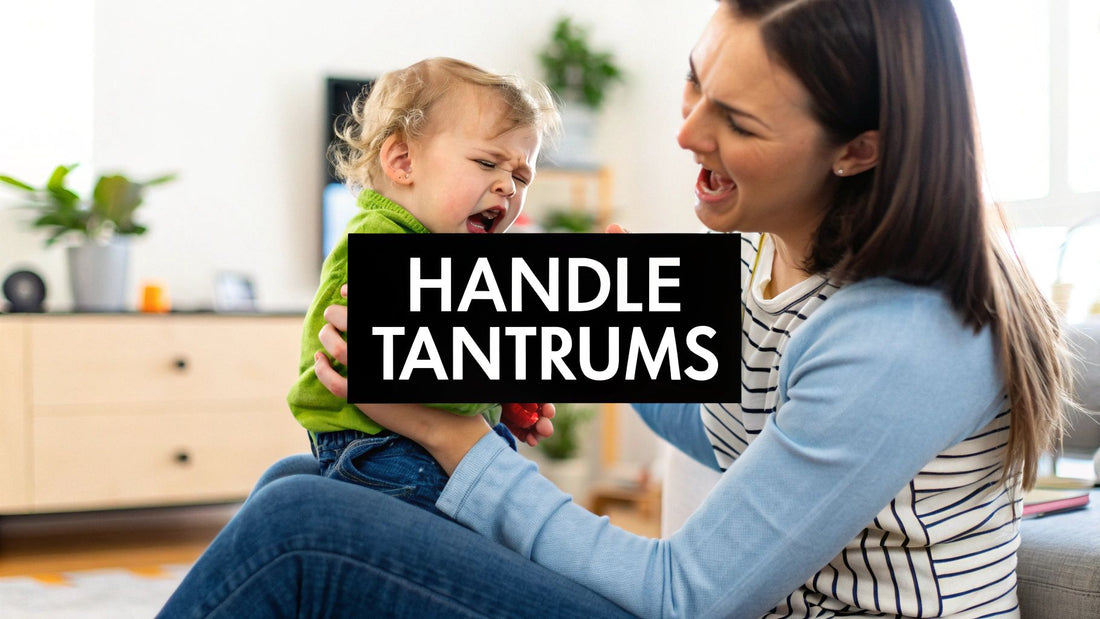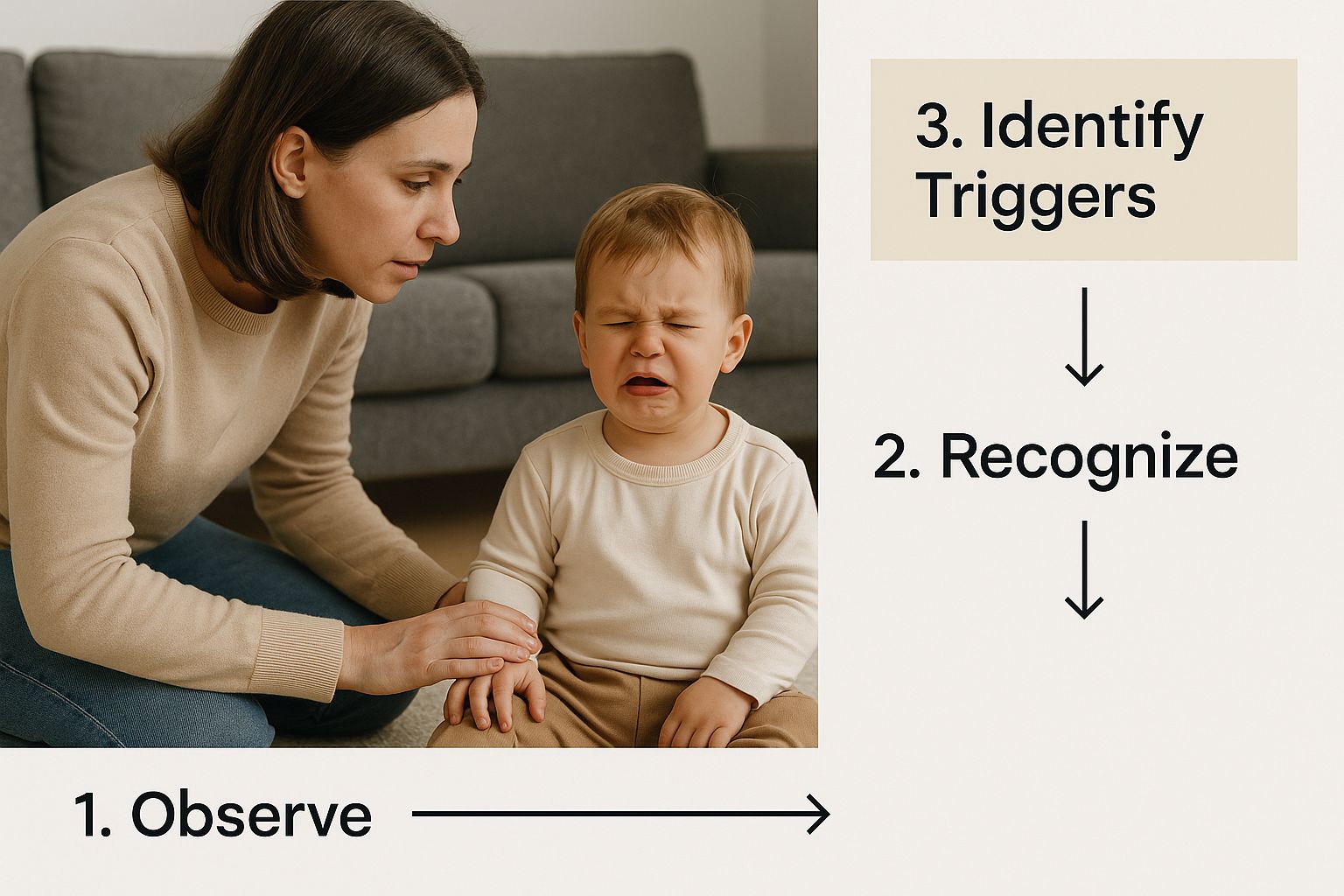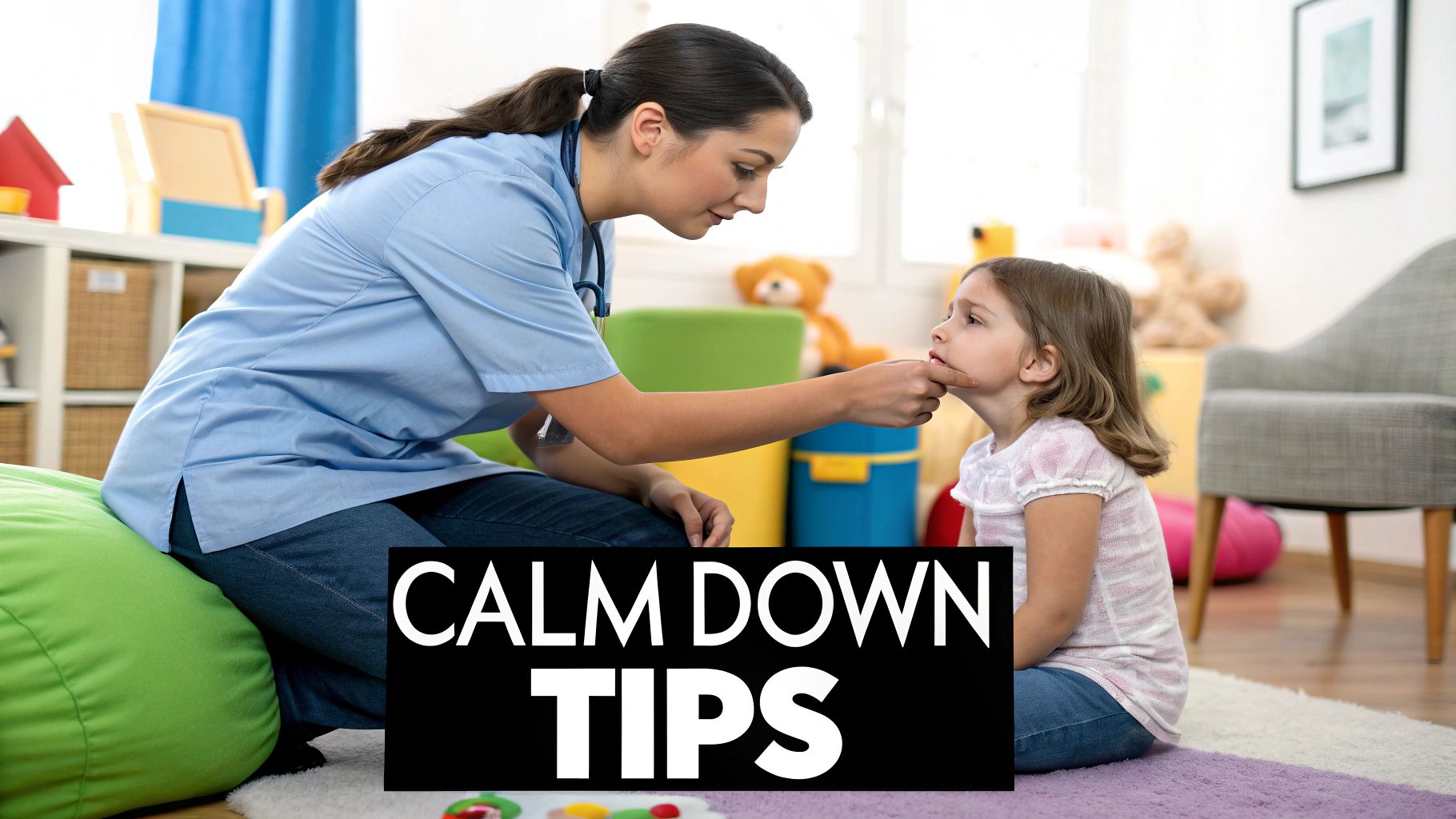
How to Handle Temper Tantrums A Guide for UK Parents
Share
The key to handling a temper tantrum often starts long before the meltdown even begins. It starts with understanding that these outbursts are a completely normal, if deeply frustrating, part of growing up. This is not about bad behaviour; it's about a young child's brain being totally overwhelmed by big feelings they cannot yet manage or put into words.
Why Toddler Tantrums Are a Normal Part of Growing Up
Before you react to a tantrum, it really helps to take a breath and remember what’s going on inside your toddler’s developing brain. It’s so easy to feel flustered, or even judged, when your little one is having a full-blown meltdown over a broken biscuit. But trust me, viewing these moments through a developmental lens can change everything.
Picture a young child whose desire for independence is exploding, yet their ability to communicate what they actually want is still pretty basic. This mismatch is the perfect recipe for frustration. They know they want the blue cup, not the red one, but they just do not have the words to explain why. That ear-piercing scream? It’s simply the only tool they have right now.
The Science Behind the Storm
A toddler's brain is still building the essential pathways for emotional regulation. The part of the brain that handles logical thinking and impulse control—the prefrontal cortex—is years away from being fully developed. When a huge feeling like anger or disappointment hits, it floods their entire system. They physically cannot "calm down" on command in the way an adult can.
According to NHS data, temper tantrums in the UK typically kick off around 18 months and are an incredibly common experience for families. These outbursts, which can sometimes include hitting and biting, are often a direct result of a toddler's struggle to express themselves when they feel intense frustration. The good news is that by the age of four, as their language and coping skills improve, these tantrums naturally become much less frequent.
It's a critical shift in mindset to see yourself not as a disciplinarian in that moment, but as a calm guide. Your role is to be the anchor in their emotional storm, helping them navigate back to safety.
To get a clearer picture of your child's growth and understand why certain behaviours pop up at certain times, it can be helpful to look at a guide to child development milestones. Seeing the broader context helps normalise these outbursts as just one stop on their journey. Using tools like books can also make a huge difference; you can learn more by exploring emotions with books for 2-year-olds.
It’s important for me to state that I am not a mental health professional. While most tantrums are a completely normal phase of development, if you have serious concerns about your child's behaviour or wellbeing, please speak with your GP or a qualified child psychologist for professional advice.
Your In-the-Moment Guide to Managing a Meltdown
When a tantrum hits, your immediate response can either pour fuel on the fire or calmly put it out. In the heat of the moment, the goal is simple: de-escalation, not discipline. Honestly, your child's brain is completely overwhelmed, so trying to use complex reasoning or negotiation is pretty much futile.
Instead, think of yourself as the calm anchor in their emotional storm. This is your chance to model the self-regulation you want them to learn, even when you're navigating a public meltdown in the middle of Tesco. A quiet voice, slow movements, and a steady presence show them they are safe, even when their feelings feel impossibly huge.
First things first, safety. Gently move your child away from anything they could hurt themselves with. If they are hitting or kicking, put yourself between them and whatever they're lashing out at. Your calm, physical presence creates a boundary that protects them and others without adding to the chaos.
This simple flow chart can help you get to the bottom of what's triggering the meltdown, which is always the first step.

Sometimes, just visualising the process reminds you that understanding the 'why' behind the meltdown is half the battle. Once you have a clue, your response becomes much clearer.
Connect Before You Correct
Next up, validate their feelings without giving in to their demands. This is such a crucial distinction, and it can feel tricky at first. The idea is to acknowledge their frustration while holding the boundary firm.
For example, your child wants a chocolate bar right before dinner. You could try saying, "I can see you're very upset that we can't have chocolate now. It's really hard to wait when you want something." Notice you aren't giving in; you are just showing them you get it. This simple act of empathy can often shorten the tantrum's duration dramatically.
When you're in the thick of it, it's easy to forget what works and what does not. Here’s a quick-reference table to help you navigate those intense moments.
Tantrum De-escalation Dos and Don'ts
| Do (The Calm Approach) | Don't (The Escalation Risk) |
|---|---|
| Use a low, calm voice. | Raise your voice or shout. |
| Acknowledge their feelings ("I see you're angry"). | Dismiss their emotions ("Stop crying"). |
| Stay physically close and available. | Send them away alone ("Go to your room!"). |
| Keep your language simple and brief. | Try to lecture or reason with them. |
Think of this as your cheat sheet for staying grounded when everything feels out of control.
Weathering the Storm Together
Ultimately, staying present is what matters most. Ignoring a tantrum can make a child feel abandoned and misunderstood when they are at their most vulnerable. Your steady presence reassures them that you can handle their big emotions, which in turn teaches them that their feelings are not scary or shameful.
Remember, your child is not giving you a hard time; they are having a hard time. They need your support, not your anger. This mindset shift is central to handling tantrums with compassion.
After the emotional storm has passed and your child is calm again, that's the perfect time for a cuddle and a brief, gentle chat. For ongoing support in developing these calming skills, resources like the That's Calm children's guided meditation ebook can be incredibly helpful. It offers wonderful tools for relaxation that you can practise together, building their emotional resilience for the future.
Uncovering Tantrum Triggers and How to Prevent Them

Often, the most powerful way to manage a tantrum is to stop it from happening in the first place. This means shifting your mindset from firefighting to detective work. Your mission? To figure out what sparks a meltdown before it ignites.
When you start spotting the patterns that come before an outburst, you can make tiny adjustments to your day that create a much calmer, more predictable world for your little one. It's really all about seeing things from their perspective and smoothing out the common rough patches.
Become a Tantrum Detective
First, let's look at the usual suspects. In the UK, common triggers like tiredness, hunger, boredom, and frustration are behind most tantrums. These are not just minor annoyances for a toddler; their developing brains simply cannot cope when these basic physical and emotional needs are not met. It might look like defiance, but it's often desperation.
To get a clearer picture, try keeping a simple diary for a week or so. You do not need anything fancy – the notes app on your phone will do. Jot down when tantrums happen, where you are, and what was going on right before things kicked off. You'll probably start to see a theme, like a regular meltdown around 11 am (hello, hunger!) or after a hectic trip to the shops.
It’s also worth noting how we, as parents, respond. One UK poll found that 52% of parents admitted to ignoring their daughters during tantrums, but only 39% ignored their sons. It’s a fascinating insight into how our own unconscious biases can shape our reactions, and something to be mindful of as you observe what's happening.
Proactive Prevention Strategies
Once you have an idea of the triggers, you can start putting some simple, proactive strategies in place. The key here is consistency. It builds a sense of safety and security for your child that makes a huge difference.
- Establish Predictable Routines: Children feel safe when they know what’s coming next. A reliable routine for meals, naps, and bedtime helps regulate their bodies and emotions, making them far less likely to have a meltdown caused by being overtired or hangry. For example, a consistent bedtime routine of bath, book, and bed can signal to their body that it's time to wind down.
- Offer Simple Choices: A huge source of frustration for toddlers is their lack of control over their world. Giving them small, manageable choices restores some of that power. Think, "Would you like the red cup or the blue cup?" or "Do you want to wear your wellies or your trainers?" It seems minor to us, but it's a big deal to them.
- Give Clear Warnings for Transitions: Abruptly ending a fun activity is a guaranteed recipe for a tantrum. Instead, provide clear, timed warnings. "We have five more minutes at the park, and then it's time to go home" gives them a chance to mentally prepare for the shift.
A tired child is a child primed for a tantrum. Protecting their sleep is one of the most powerful prevention tools you have. An overstimulated brain has no resources left for emotional regulation.
So many tantrums are born from pure exhaustion. Making sure your child gets enough quality rest can dramatically reduce the frequency and intensity of their meltdowns. For some great advice on creating a peaceful sleep environment and figuring out what your little one should wear to bed, you might find these expert tips on baby sleep really helpful. These small tweaks can honestly make a world of difference.
Building Emotional Resilience After the Storm
Once the tears have dried and the tantrum has passed, what happens next is just as important as how you handled the meltdown itself. These quiet, calm moments are a golden opportunity to connect with your child and do some gentle teaching. The first step is simple: reconnect.
A warm hug, a snuggle on the sofa, or just sitting closely together sends a powerful message: "I love you no matter what." It's so important to separate their behaviour from their identity. They are not a "naughty" child because they had big feelings; they are a wonderful child who was having a really difficult time.
Name It to Tame It
When everyone feels settled again, you can gently start to make sense of what happened. This is where the brilliant "name it to tame it" strategy comes in. This is not about lecturing them or telling them off. It's about giving them the words for the huge feelings that overwhelmed them.
You could try saying something like, "Wow, that was such a huge feeling. You felt so frustrated when your tower fell down, didn't you?" Or perhaps, "It felt really sad when we had to say goodbye to Grandma." This simple act helps build their emotional vocabulary and self-awareness, laying the groundwork for better self-regulation down the line.
Reconnecting after a tantrum teaches your child that no feeling is too big or too scary to bring to you. It builds a foundation of trust and shows them that relationships can be repaired after a conflict—a crucial life skill.
Helping your child find the right words is a key part of developing their emotional intelligence. For more practical ideas, you can explore our guide on teaching kids about feelings, which offers more tools for these important conversations.
Opening Conversations Through Stories
Books are a fantastic, gentle way to explore emotions together. Cuddling up with a story about a character who feels angry, sad, or frustrated helps normalise these feelings for your child. It opens up a safe space to talk about difficult emotions away from the heat of the moment.
Look for books that can help you start these conversations:
- The Colour Monster by Anna Llenas: This popular book helps children identify and separate their mixed-up feelings using colours.
- Ruby's Worry by Tom Percival: A beautiful story that shows how worries can shrink when you talk about them.
- Grumpy Monkey by Suzanne Lang: This book demonstrates that it's okay to feel grumpy sometimes and you don't have to pretend otherwise.
This work you do after the storm is not about discipline; it's all about connection and education. By consistently offering comfort and guidance after a meltdown, you are nurturing your child’s long-term mental health and building their resilience, one storm at a time.
When to Seek Professional Support for Your Child

While the odd meltdown is a completely normal part of childhood, it's just as important to trust your gut as a parent. If you have a nagging feeling that the tantrums are becoming unmanageable, or they just seem different from what you see in other children, it’s absolutely okay to seek reassurance and support. Knowing when to ask for help is a sign of strength, not failure.
According to the NHS, one in six children aged 5-16 in the UK are identified as having a probable mental health problem. Addressing these concerns early is one of the most proactive and loving things you can do for their long-term wellbeing, preventing challenges from escalating into more serious issues later in life.
That said, some patterns can signal that your child might need a bit of extra support with their emotional and mental health. Spotting these concerns early is key.
Red Flags to Be Aware Of
It’s rarely about a single, huge tantrum and more about the bigger picture. If you’re noticing a persistent pattern of the following behaviours, it might be time to have a chat with a professional.
- Age and Frequency: The tantrums are getting more frequent or intense after the age of five. By this point, most children have developed better language and self-regulation skills.
- Safety Concerns: The outbursts regularly involve self-harming behaviours, like head-banging or biting themselves. Or perhaps they are frequently aggressive towards you, siblings, or even pets.
- Impact on Family Life: The tantrums are so severe or constant that they’re seriously disrupting your family's daily life. Maybe you've started avoiding leaving the house, or it's putting a significant strain on your own mental health and impacting your work. Poor mental health in the UK workforce costs businesses up to £56 billion a year.
- Inability to Recover: Your child really struggles to calm down, even with your support. The meltdowns regularly last for an unusually long time (say, more than 25-30 minutes).
Please remember, I am not a mental health professional. This information is for guidance only. If you are worried about your child's behaviour or your own mental health, your first and best step is to speak with your GP or a qualified child psychologist. They can offer tailored advice and support.
Trusted UK Resources for Support
Knowing where to turn can feel overwhelming, but there are some fantastic organisations in the UK dedicated to supporting families just like yours. You are not alone in this.
- NHS: Your GP or Health Visitor is the perfect starting point. They can rule out any underlying physical issues and refer you to specialist services like Child and Adolescent Mental Health Services (CAMHS) if it’s needed.
- YoungMinds: A leading UK charity fighting for children and young people's mental health. Their website and parents' helpline offer a wealth of information and confidential advice.
- Family Lives: This brilliant charity provides support for all aspects of family life, including a confidential helpline and fantastic online resources for managing challenging behaviour.
A Few Common Questions I Hear from Parents
When you're in the thick of it with tantrums, it's natural to have questions swirling around your head. Let's tackle some of the ones I hear most often from parents across the UK, offering some practical advice for those really tough moments.
Is It Okay to Just Ignore a Tantrum?
This is a tricky one, and honestly, the answer is: it depends entirely on why it's happening.
If you're pretty sure the tantrum is purely for attention and your child is completely safe, a strategy called ‘planned ignoring’ can sometimes work wonders. It sends a clear message that the outburst is not the magic button to get what they want.
But, and this is a big but, if your child is genuinely distressed, overwhelmed, or has hurt themselves, ignoring them can feel like abandonment. This will only ramp up their anxiety. A much better approach in these situations is what I call ‘calm presence’. This simply means staying physically close without getting pulled into the drama. You become a safe, steady anchor they can come back to once the storm has passed. You’re not rewarding the behaviour, but you are supporting your child.
How on Earth Do I Handle a Tantrum in the Supermarket?
Ah, the dreaded public tantrum. It can feel incredibly stressful because you can almost feel the weight of strangers' eyes on you. The first rule here is to focus on your child, not the audience. Trust me, most of the people watching are probably other parents who have been right where you are. Social media often portrays a perfect image of parenting, but the reality is that nearly every parent has dealt with a public meltdown.
If you can, try to move to a quieter spot—a deserted aisle, back to the car, or just outside the shop doors can make a world of difference. Get down to their level and use a low, calm voice to acknowledge how they're feeling: "I know it's really hard to leave the toys behind." Hold the boundary gently but firmly. Your goal is to help your child navigate their emotions, not to put on a show for other shoppers.
My Child’s Tantrums Seem So Much Worse Than Their Friends’. Should I Be Worried?
It’s so easy to fall into the comparison trap, but it rarely helps. Every child develops at their own unique pace. More than anything, trust your parental instincts. While most tantrums are a completely normal phase, there are definitely times when it’s wise to get a professional opinion.
If the tantrums are still frequent and intense after the age of five, if they involve extreme aggression or self-harm, or if they're causing significant stress for the whole family, it’s a good idea to have a chat with a professional. As a parent, managing this stress is also vital. Simple relaxation tips like deep breathing (inhale for four, hold for four, exhale for six) or stepping away for a minute can make a huge difference.
Your GP or Health Visitor is a brilliant first port of call. They can help rule out any underlying issues, like sensory processing challenges or anxiety, and can point you towards the right support services in the UK. Reaching out for help is not a sign of failure; it's a proactive and loving step for your family's wellbeing.
Remember, you are not alone in figuring out how to handle temper tantrums. These phases are tough, but with consistency, empathy, and the right support, you and your child will get through them together.
At Little Fish Books, we believe in nurturing emotional literacy from a young age. Explore our collection of books, mental health apparel, and resources designed to help children understand their big feelings. Find the perfect tools to support your family's emotional wellbeing at https://thatsokay.co.uk.
